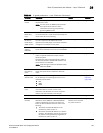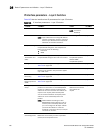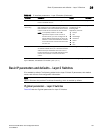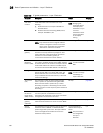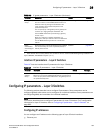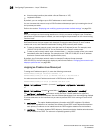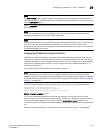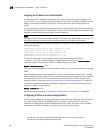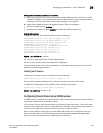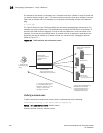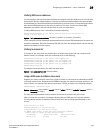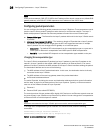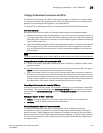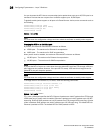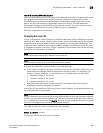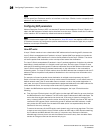
PowerConnect B-Series FCX Configuration Guide 803
53-1002266-01
Configuring IP parameters – Layer 3 Switches
26
Configuration limitations and feature limitations
• When configuring IP Follow, the primary virtual routing interface should not have ACL or DoS
Protection configured. It is recommended that you create a dummy virtual routing interface as
the primary and use the IP-follow virtual routing interface for the network.
• Global Policy Based Routing is not supported when IP Follow is configured.
• IPv6 is not supported with ip-follow.
• PowerConnect devices support ip-follow with OSPF and VRRP protocols only.
Configuration syntax
Configure IP Follow by entering commands such as the following.
PowerConnect(config)# vlan 2 name IP-Subnet_1.1.2.0/24
PowerConnect(config-vlan-2)# untag ethernet 1 to 4
PowerConnect(config-vlan-2)# router-interface ve1
PowerConnect(config-vlan-2)# interface ve 1
PowerConnect(config-vif-1)# ip address 10.10.2.1/24
PowerConnect(config-vif-1)# interface ve 2
PowerConnect(config-vif-2)# ip follow ve 1
PowerConnect(config-vif-2)# interface ve 3
PowerConnect(config-vif-3)# ip follow ve 1
Syntax: [no] ip follow ve <number>
For <number> enter the ID of the virtual routing interface.
Use the no form of the command to disable the configuration.
Virtual routing interface 2 and 3 do not have their own IP subnet address, but are sharing the IP
address of virtual routing interface 1.
Deleting an IP address
To delete an IP address, enter a command such as the following.
PowerConnect(config-if-e1000-1)# no ip address 1.1.2.1
This command deletes IP address 1.1.2.1. You do not need to enter the subnet mask.
To delete all IP addresses from an interface, enter the following command.
PowerConnect(config-if-e1000-1)# no ip address *
Syntax: no ip address <ip-addr> | *
Configuring Domain Name Server (DNS) resolver
The DNS resolver is a feature in a Layer 2 Switch or Layer 3 Switch that sends and receives queries
to and from the DNS server on behalf of a client:
You can create a list of domain names that can be used to resolve host names. This list can have
more than one domain name. When a client performs a DNS query, all hosts within the domains in
the list can be recognized and queries can be sent to any domain on the list.
When a client performs a DNS query, all hosts within that domain can be recognized. After you
define a domain name, the Dell PowerConnect device automatically appends the appropriate
domain to a host and forwards it to the DNS servers for resolution.



